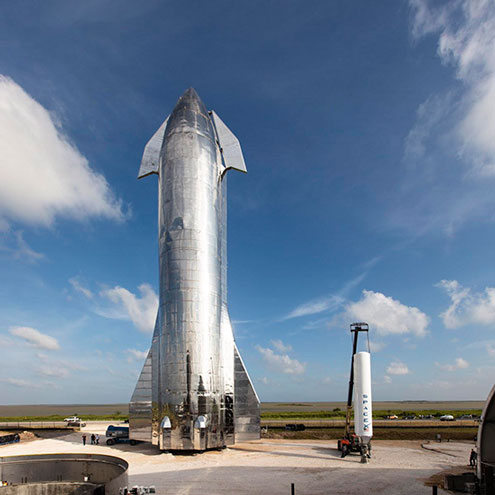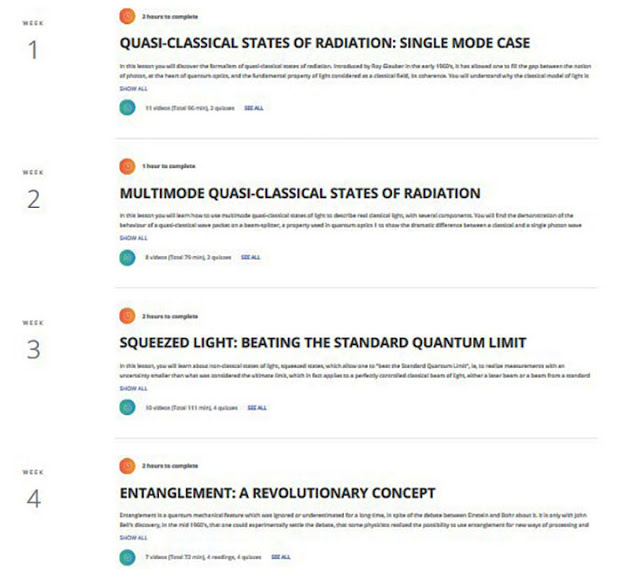Well we have had some rain and cloudy weather that cancelled this month's OCA star party, but looking up at the sky is what Elon Musk did in his annual review of the Starship and Super Heavy progress.
Now some of us have been luck enough to have witnessed in person earlier launches of SpaceX Falcon Heavy from the Kennedy Space Center (see blog post of February 8, 2018) or the Falcon 9 launch from Vandenberg (see blog post of October 8, 2018), but to watch this giant Starship take off and then re-land has got to be our next go to launch. Now I don't even know if we can get close to the launch site or any of those details, but it is certainly something to look at putting the event, whenever the event is, on our calendar.
I had no idea of how big this Starship rocket was supposed to be, but just take a look at the size of this thing next to one of the Falcon One rockets. Just imagine this huge thing blasting off and then coming back and landing again, just like rockets in the 50's scifi movies used to do! Wow, if anybody can do such a crazy thing and take this rocketship to Mars, I guess Elon is our guy! You can get the rest of the story and more details by going to the source reference in the figure caption.
 |
| SpaceX Starship next to Falcon One Source( https://www.space.com/spacex-starship-reach-orbit-six-months.html) |
Elon made this announcement on September 28 from SpaceX location in Boca Chica, which is next to one of their production facilities in Brownville, Texas. Now I know Texas is pretty big, but how are you going to be able to launch a big rocket from there? Well, a little more internet searching found a map of where Brownville is located and now you can see how a launch from there might work. Not much between the launch site and the Gulf of Mexico. And for us getting to that location, multiple airlines offer one stop flights to Brownsville from Orange County. So, let us know when it is going to happen, Elon, and we will make our way to the show!
 |
| SpaceX space port launch site near Brownsville, TX (Source: Wikipedia) |
Another big event for this week was that it was now our time for a tour of the James Webb Space Telescope (JWST). The JWST is undergoing final testing at Northrop Grumman Space Park in Redondo Beach and public tours are available. We had hoped to participate in the OCA scheduled tour, but our travel schedule precluded making that tour, so we took advantage of a tour (listed as a benefit of membership, but they let us join in) offered by Ventura County Astronomical Society (VCAS). You have to sign up in advance to go on this tour and you can' just show up.So, Resident Astronomer Peggy and I sent our info to VCAS and they secured our visitor badges and we then made our long 1.5 hour morning drive through rush hour traffic to Redondo Beach. You know you are getting close to your destination when you can see the E2 building from the 405 Freeway. Our tour guide was Phil Regier, VCAS President, who we met up at Northrop Grumman building E2, where we picked up our visitor badges and first toured a small museum of space and satellite memorabilia, including one of the spare Pioneer 1 satellites and various models of other aircraft and space missions, like the Apollo Lunar Lander, and space observatories, like Chandra X-ray telescope and the TESS satellite. You can check out many of the other space programs and history at: https://www.northropgrumman.com/MediaResources/MediaKits/Space/Home.aspx
 |
| After signing up for a tour we just navigated to the tour start at Building E2 (Source: Northrop Grumman) |
Next, Phil took us on a walking tour of various building on the space park campus where we toured the offices of various JWST design and test teams and environmental test laboratories (M1, M2, M4 and M8, as I recall) where spacecraft are subjected to vacuum and temperature extremes of space and the vibration and acoustic noise associated with the rocket launch into orbit. It was pretty neat touring these facilities, just seeing the size and scale necessary to test large satellites like the JWST.
Finally, we made our way to the clean room where the JWST is undergoing final testing. This is where our eyeballs could see the JWST, but unfortunately no cameras were allowed. Wow, it was really impressive to see the JWST, integrated with the bus, and with its sunshade unfurled and white suited engineers roaming around and making tests and measurements! The secondary mirror had been deployed last week but was now in its retracted position and the side sets of hexagonal mirrors were also folded back.
Darn, we can't share any photos of our tour, but there are plenty of official photos available online. Check out this photo of the JWST which was probably taken within the last month or so.
 |
| JWST in the clean room at Northrop Grumman (Source: https://www.jwst.nasa.gov/) |
Also if you haven't seen the overall structure of the JWST for sometime, this graphic shows some of the details. During the tour, I learned that the mirror assembly is fixed in position on the whole satellite and does not move independently. So to point the telescope at some targeted object it is necessary to move the whole satellite while at the same time keeping the sunshade facing the sun and the high gain antenna pointing towards the Earth. Also, as a fuel conservation measure the JWST design includes a trim flap, that uses the momentum of sunlight to help control the position of the satellite while it is in orbit at its L2 location. That is a pretty neat trick!
 |
| JWST main features and components (Source: https://www.jwst.nasa.gov/) |
So, all in all, regardless of having to struggle through morning rush hour freeway traffic, we had a great time and tour. We also walked to the S-Café and had a great lunch (Baked Talapia with vegetables) after the tour and of course just had to buy a few trinkets and shirts at the NG Store. In addition, we have to give a final thank you to VCAS and Phil for volunteering to lead us around and fill us in on many of the technical issues. For security reasons you must pre-register, you cannot just show up for the tour. You can check in and sign up on the VCAS website (https://www.vcas.org) for tours on most Mondays. Thanks for that Phil!
Ok, after a great tour and imagining viewing the upcoming rocket launch from Texas it is time to go back to "work" and sign up for a couple of new free online courses from Coursera. This course by Professor David Archer, U. of Chicago, has so far been great. All you need for prerequisites is a bit of high school algebra and a little science background. I look forward to the upcoming sessions! Remember the course is free; just select to audit the course without getting a certificate.
 | |
|
The other course now available from Coursera is this Part II of Quantum Optics. Check out the short course syllabus below. Make no mistake here, this is a full blown technical course and you better have some quantum mechanics in your background to hang in on this course. My specific interest is that it will cover the concept of "squeezed light", which is currently or is going to be shortly incorporated into the latest LIGO interferometer design. Squeezed light is a quantum optical technique to achieve even better accuracy and achieve higher sensitivity in LIGO search for gravitational waves. Also the section on entanglement should be very interesting. If you have been following our discussion of Sean Carroll's "Something Deeply Hidden" you know that entanglement is now becoming a central part coming to grips with the fundamental nature of gravity, entropy and spacetime. So, buckle your seat belt and break out your old quantum mechanics texts and dive in!
 |
| Syllabus for Quantum Optics II (Source: www.coursera.org) |
Until next time,
Resident Astronomer George
Be sure to check out over 300 other blog posts on similar topics
If you are interested in things astronomical or in astrophysics and cosmology
Check out this blog at www.palmiaobservatory.com

No comments:
Post a Comment